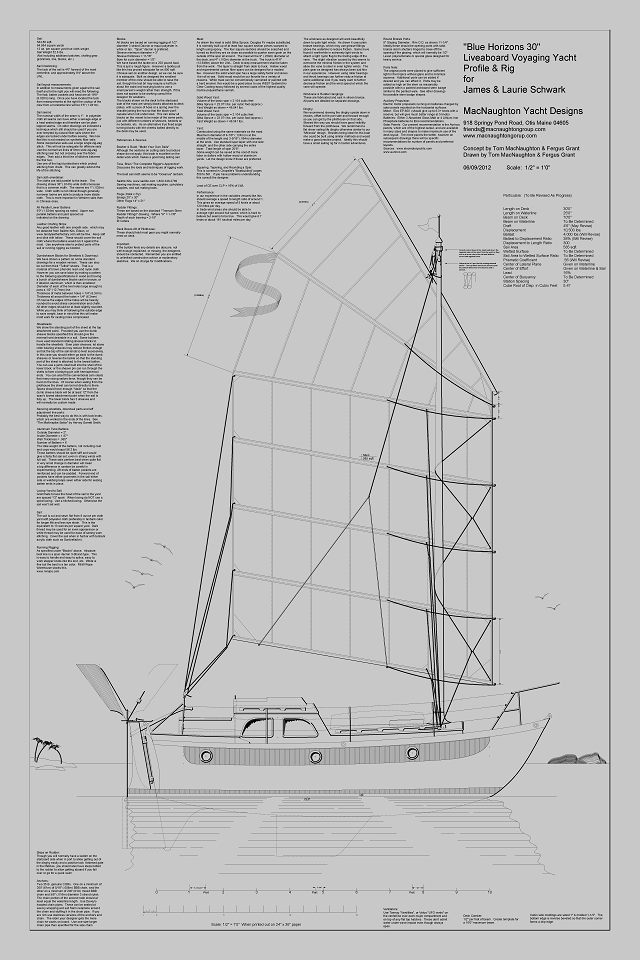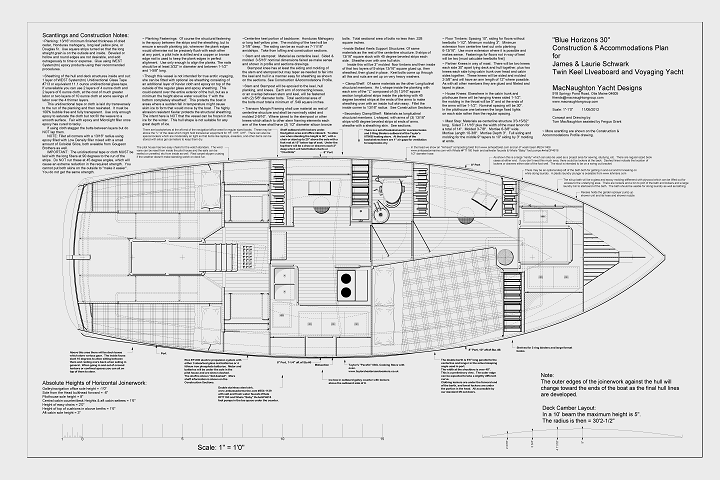
Blue Horizons 30

Blue Horizons 30 is a twin
keel ultimate voyaging yacht with Chinese rig. A twin keel boat is easy to
beach for routine bottom painting and other work. The slightly shoaler
keels of 4'6" draft are just right for shallow areas like parts of the Bahamas,
the Keys, and the Chesapeake, plus a great many other places throughout the
world. Twin keels are exceptionally good to windward in moderate to heavy
winds.
With 10'0" beam and a nearly flush deck we can get an enormous amount of room into the interior.
This particular type, though the nominal displacement to length ratio is in the lower
range for serious liveaboard voyaging yachts, can accept a wide range of loads
without a performance penalty. Twin keels work well offshore because the
unusual dynamic characteristics will give her a level of comfort normally
associated with heavy long keel vessels. This starts with the fact that twin keel vessels
with skeg hung rudders tend to be steadier on the helm than fin keel spade
rudder coastal cruisers, therefore much less tiring to hand steer if necessary,
and much easier to handle well with a simple robust wind vane steerer.
Further the increased roll moment of inertia of twin keels reduces roll
considerably through two factors. The first is the concentration of
ballast relatively low in the relatively long total length of keel bottom which
slows the roll through a generous vertical arm. The second factor divides
the ballast into two pieces, well separated from each other laterally, thus also
increasing the roll moment of inertia. All this, combined with the twin
keeler's tendency to entrain a large mass of water with the vessel when rolling,
gives both enormous resistance to rolling and very quick damping of any roll
which does develop. Blue Horizons 30 will be
unusually comfortable at sea, and in harbor, or in coastal cruising, powerboat
wakes will be much less offensive as it is harder to start the boat rolling and
the rolling damps down very quickly.
In many very crowded harbors there are large areas where no boats anchor or moor
because these areas are shallow at low tide. A boat like this will be able
to anchor there and have plenty of swinging room.
Another advantage lies in the ability, if desired, to put a twin keel yacht on
the deck of a larger vessel or special purpose yacht transport vessel.
This can allow someone pressed for time or with health problems to get their
vessel to a new cruising ground more easily.
These days the increased number of experienced voyagers has brought more support
for a pilot house with all controls and sail handling led to it. These
days it is widely understood that living aboard and long term cruising and
voyaging is different from holiday cruises. Being able to stay out of
wind, rain, spray, cold, hot sun, etc. reduces fatigue a great deal. The
crew tends to end up spending a great deal of time in the pilothouse.
Blue Horizons 30 has plenty of height under the side
decks for generous sitting headroom, with the ports in a contrasting wale in the
topsides. Though almost flush decked there is a low trunk without ports to
give generous headroom without excessive topsides height. There is plenty
of room on the top of the pilothouse and this low trunk to have plenty of solar
panels, and still have space for a three piece sailing dinghy just aft of the
mast.
This vessel is a perfect size for a couple or small family to liveaboard.
People you will meet who have been living aboard for less than a year seem to be
setting out on boats averaging in the neighborhood of 40+ feet.
However, if you poll only people who've been living aboard and voyaging for
more than a year you've already dropped to 35 feet average length.
If you look at people who've been living this life for more than three years the
average size is just a hair under 30'.
Another point is that by eliminating the sunken cockpit in favor of deck box
seating we add another cabin below and have the interior of a much larger
vessel. You also have a safer vessel in that the cockpit doesn't hold a
huge weight of water anymore if a wave goes over the boat and you eliminate the
major cause of broken bones on yachts, which is falling into the cockpit.
A great many people have eliminated cockpits on their boats in favor of deck box
seating. Many experienced sailors have chosen designs of ours partly for
that reason.
The particulars are as follows, but remember that displacement will vary a bit
with loading:
Length on Deck
30'
Length on Waterline 25'
Beam
10'0"
Draft
4'6" (varies with loading)
Displacement
10,500 pounds
D/L Ratio
300
Scantlings Numeral 5.47 (cube root of displacment
in cubic feet)
Ballast Percentage 40% (approximate)
Ballast
4,200 lbs of lead
Prismatic Coeff. .56
Sail Area
585 square feet
The lines are very carefully faired for best flow and the rudder skeg and keel
roots are carefully faired to eleminate humps and hollows in the water flow as
far as possible. Using a skeg hung rudder makes it much harder for the
rudder to be stalled in adverse conditions. As an outboard rudder it is
more easily repaired on a beach if necessary, though this skeg and rudder
combination and the windvane are made as robust as possible and are hopefully
nearly invulnerable to damage.
The combination of the moderate length twin keels and the substantial skeg hung
rudder result in a vessel steady on the helm and easily controlled by a windvane
even in heavy weather.
The outboard rudder allows a simple, robust trim tab type wind vane steerer,
which can be adjusted from the pilot house when desired. This allows the
watch at sea to sit comfortably in a pilot house armchair and just keep a
lookout. This avoids fatigue and can make ocean crossings and periods of
inclement weather much more enjoyable.
The single Chinese sail allows plenty of sail area in a rig that is self-tending
in tacking and can be hoisted, lowered, reefed and unreefed entirely from the
pilot house. The rig has been deliberately designed to be easy for small
or older people to handle. The ease of reefing and unreefing allows having
the optimum sail area up a much greater percentage of the time. The mast
can be either solid laminated wood or a very light hollow carbon fiber mast.
These days with the cost about the same most will go for the carbon fiber spars.
The rig is arranged so that the spar can be pulled using gear on board if you
find you wish to enter a canal system with low bridges.
The safety advantage of an unstayed rig from a structural point of view is in
the reduced number of possible failure points. You have only one design
problem: Is the mast strong enough to carry the load with enough safety
factor so that it will never be loaded enough to fatigue.
Over and over our clients, for whom we have designed Chinese rig vessels
optimized for living aboard and ocean voyaging, have told us that they were
surprised to find that they were able to beat the pants off of many boats of
similar size and even quite a few larger ones, even to windward. We
discuss why in detail in the Study Plans but the jist of it is that the upper
part of the sail uses a different type of lift than the theoretical "foil" lift
we are used to thinking about. This is called "vortex lift" and has only
been recognized in both yacht and aircraft design quite recently and has still
not really reached the level of public understanding.
For construction we have used the highly efficient "sheathed strip" construction
in which the hull and deck are built using longitudinal square section strips,
sheathed transversely inside and out to give a very strong for the weight and
very damage resistant construction. In addition the entire vessel has been
lofted in the computer so that the plans can include dimensioned patterns or CNC
files for virtually every major part of the vessel. These days your
supplier can precut a building jig, interior joiner work parts, etc., so that
whether built by an amateur or a professional will basically amount to
assembling a kit. While we discuss this extensively in the Study
Plans text, surfice it to say for now that custom built boats like this are
these days no more expensive than a comparable quality stock boat. That is
if you could find a comparable quality stock boat. Since this also cuts
out the huge ad budgets that a stock boat builder must shell out to keep selling
essentially the same boat over and over, it is quite likely that the custom
vessel may end up actually costing significantly less.
While there is a long section in the Study Plans on the accommodations, we will
content ourselves here with simply adding a plan view showing everything in as
artistic a manner as we can. It should give you a decent idea of the
general arrangement, though not a lot on the details:

About the only bit of the accommodations which you probably can't sort out easily is the bit forward of the mast in the forward cabin
and aft of the double chain locker. This is a nice comfortable sit up
bath.
Though you could use a standard small diesel quite easily, what the drawings
actually show under the pilothouse sole between the two arm chairs is an
electric propulsion unit and batteries. Since the auxiliary is used in
calms, getting in and out of harbors, and in canal systems, it is quite easy to
charge the batteries entirely from the solar panels. To summarize a very
long section on the electric propulsion we can get quite close to hull speed as
a maximum from quite a modest electrical motor. If we drop back the speed just a
bit from that into a speed range that an ocean crossing power yacht would use
the range becomes quite large.
These days everyone has a list of electronics which the magazines make sound
quite necessary. We would very strongly urge having the absolute minimum
you can persuade yourself to buy at first. Probably a handheld GPS or a
small chartplotter, a handheld VHF for emergencies and weather forecasts, and
perhaps a depth sounder. Beyond this make a list of what you think you
want and keep it in your manuals binder. Whenever it occurs to you that
you'd really like to have one of these items, put the date next to it on the
list. After a year of living aboard and traveling review the list.
It will be amazing how few items have even one date after them. If you
find an item that you repeatedly put a date beside, that's the one to get.
The more you add the more of your time you spend just trying to keep everything
working. As our friend Kent says, "The Caribbean is full of 40' plus boats
with one guy on board who says that his wife will come back when he gets
everything working."
Our personal voyaging days are, sadly, over. We're just too creaky.
Don't wait. Get going now.
Blue Horizons 30 Study Plans, $66:
Blue Horizons 30 Complete Plans, Fully Lofted, $3,706: Blue Horizons 30 Complete Plans, Without Lofting, $2,022: